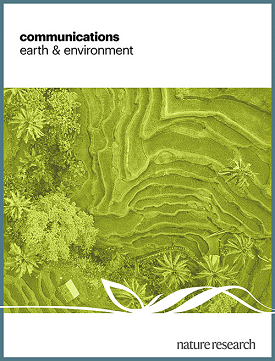北极野火烟雾对健康的巨大跨界影响
IF 8.1
1区 地球科学
Q1 ENVIRONMENTAL SCIENCES
引用次数: 0
摘要
近年来,高纬度地区,尤其是西伯利亚地区的快速变暖导致了大面积的野火,造成了大范围的烟羽。这些大火导致该地区夏季空气质量大幅恶化,1998-2020 年间,西伯利亚部分地区夏季细颗粒物(PM2.5)浓度增加了 4 倍。暴露于 PM2.5 与心血管和呼吸系统疾病导致的死亡风险增加有关,PM2.5 在大气中的寿命意味着它可以在地区和国家之间有效传播。我们利用社区地球系统模型量化了北极理事会成员国发生的高纬度野火造成的 PM2.5 分量,并估算了当地和邻国的可归因健康影响。在 2001-2020 年期间,我们认为北极理事会野火平均每年会导致约 21,000 人超额死亡,其中约 8000 人发生在北极理事会以外的国家。我们的分析表明,在 2001-2020 年期间,尽管野火产生的 PM2.5 有所上升,但北极野火对健康的影响却有所下降,我们认为这是由于西伯利亚野火的平均纬度向北移动,减少了对人口密集地区的影响。地球模型模拟显示,2001 年至 2020 年间,北极地区的大型野火每年造成约 21,000 人超额死亡,其中约 8,000 人发生在北极理事会以外的国家。本文章由计算机程序翻译,如有差异,请以英文原文为准。

Large transboundary health impact of Arctic wildfire smoke
Rapid warming at high latitudes, particularly in Siberia, has led to large wildfires in recent years that cause widespread smoke plumes. These fires lead to substantial deterioration in summer air quality in the region, with a factor 4 increase in summer fine particulate matter (PM2.5) concentrations in parts of Siberia during 1998–2020. Exposure to PM2.5 is associated with increased risk of mortality due to cardiovascular and respiratory disease, and the atmospheric lifetime of PM2.5 means that it can be efficiently transported between regions and nations. We used the Community Earth System Model to quantify the fraction of PM2.5 attributed to high latitude wildfires that occur in the Arctic Council member states and estimated the attributable health impact locally and in neighbouring countries. During 2001–2020 we attribute ~21,000 excess deaths to Arctic Council wildfires on average each year, of which ~8000 occur in countries outside the Arctic Council. Our analysis shows that the health impact of Arctic wildfires decreased during 2001–2020, despite the increase of wildfire-sourced PM2.5, which we suggest is due to a northwards shift in the average latitude of Siberian wildfires, reducing their impact on more densely populated regions. Large Arctic wildfires have caused around 21,000 excess deaths each year between 2001 and 2020, of which roughly 8000 occurred in countries outside the Arctic Council, suggest Earth model simulations.
求助全文
通过发布文献求助,成功后即可免费获取论文全文。
去求助
来源期刊

Communications Earth & Environment
Earth and Planetary Sciences-General Earth and Planetary Sciences
CiteScore
8.60
自引率
2.50%
发文量
269
审稿时长
26 weeks
期刊介绍:
Communications Earth & Environment is an open access journal from Nature Portfolio publishing high-quality research, reviews and commentary in all areas of the Earth, environmental and planetary sciences. Research papers published by the journal represent significant advances that bring new insight to a specialized area in Earth science, planetary science or environmental science.
Communications Earth & Environment has a 2-year impact factor of 7.9 (2022 Journal Citation Reports®). Articles published in the journal in 2022 were downloaded 1,412,858 times. Median time from submission to the first editorial decision is 8 days.
 求助内容:
求助内容: 应助结果提醒方式:
应助结果提醒方式:


